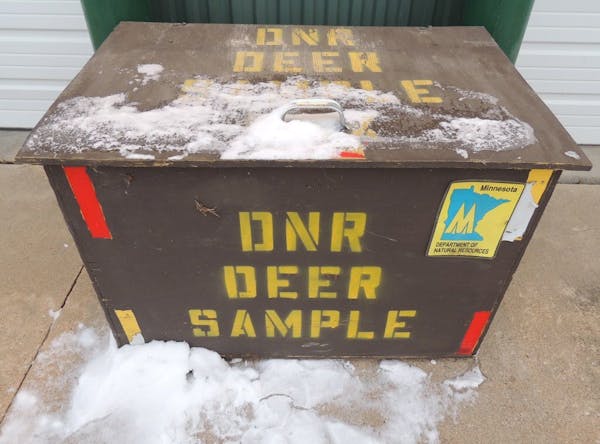MEADOWLANDS, MINN. — Upon being married in Duluth in 1903, Solomon Saxe promptly departed for a three-week honeymoon in Germany. A successful businessman in Eveleth, Minn., Saxe owned considerable properties, including the town site of Sax, southwest of Eveleth, which at its bustling peak, between 1916 and 1930, possessed its own post office.
The other day, I passed through Sax but wouldn't have known it except that the map I held indicated I had been there and gone simultaneously. The SUV ahead of me was licensed in New York and the truck I saw in my rear-view mirror also bore out-of-state plates. The presence of these vehicles amid these hinterlands certainly would have surprised Solomon Saxe, had he survived to the 21st century.
Sax, after all, and a nearby community, Zim, were founded as gateways to farming country, which is why much of the region was ditched and ditched again: for crop planting and cattle raising.
Yet this boggy region remains in many ways unchanged from a century and more ago. Black spruce, tamarack and northern white cedar dominate its lowlands, while jack pine, white spruce, aspen, birch, red pine and balsams cling to its higher grounds.
Interspersing these woods are meadows cleared by the area's early settlers, who believed, largely incorrectly, they could improve the land for farming and ranching.
Today those meadowlands lie scattered among a world-renowned 300-square-mile birding area known as the Sax-Zim Bog. Integral components of the region's ecology, the grassy areas are primary breeding grounds for voles, a priority prey of owls.
"Voles are incredible breeders, and owls eat a lot of voles,'' said Sparky Stensaas, executive director of a group he founded called Friends of Sax-Zim Bog (saxzim.org).
Gestation for female voles is 20 days, and a mother vole can produce as many as 17 litters a year, with up to 10 young in a litter. The babies, in turn, can breed in three weeks.
Yet Jeff Kaboly and Tom Buchner didn't fly to Minneapolis from their homes near Philadelphia last Sunday and drive north to Sax-Zim's lowlands and uplands to see voles. On their checklist instead were the owls that feast on voles.
Great gray and barred owls are fetured residents of Sax-Zim, while northern hawk owls and the occasional boreal owl are among winter interlopers. Commonly also on site in winter are pine grosbeaks, common and hoary redpolls, boreal chickadees, white-winged crossbills, evening grosbeaks and northern shrikes.
Outfitted from head to toe in bulky winter clothing, Kaboly and Buchner were shin-deep in snow alongside tripod-supported cameras when I bumped into them Monday. Their eyes and their cameras' 600mm lenses were fixed on a lowland black spruce about 30 yards distant.
"There's been a barred owl coming and going from that tree,'' Kaboly said. "We have photos of him sitting on a limb. Now we're trying to get shots of him flying onto that limb or leaving it. Our cameras are manually focused on very specific areas.''
This is the second consecutive winter the two have visited Sax-Zim, which expects some 4,500 tourists from mid-December through mid-March, most from outside Minnesota. The influx represents about a $1 million boost to the northeast Minnesota economy.
Stensaas, along with other Friends of Sax-Zim Bog members, regularly receive calls from birders worldwide who want to know the best times to see not only the area's birds, but its resident mammalian critters, including moose, wolves, porcupines, pine martens, bobcats and ermine.
"An Alabama woman once called me six years straight, wanting to know when she could see a boreal owl,'' Stensaas said. "She had close to 700 species on her birding list, which is a very elite club. Finally, I told her there's a boreal here and she flew up the next day and saw it.''
As recreationist birders and more-or-less amateur nature photographers, Kaboly and Buchner are perhaps more typical of Sax-Zim visitors. Buchner grew up hunting pheasants and quail in Iowa. But he gave up the pastime after moving to Pennsylvania.
"There are parallels between hunting and birding,'' he said.
Keen followers of birding websites, Kaboly and Buchner knew when they landed in Minneapolis that a boreal owl had been sighted at a feeder along Admiral Road in Sax-Zim. Hoping to see and photograph it, they raced north, making no stops.
"Between 3 and 4 that afternoon, we saw four owls: a northern hawk owl, a snowy owl, a barred owl and the boreal owl,'' Kaboly said. "It was the last time the boreal was sighted before we left Thursday morning.''
Not far from where Kaboly and Buchner stood, I wandered in an endless spruce thicket searching in vain for an American three-toed woodpecker. Then I checked another site for the elusive boreal owl before making my way to the Sax-Zim Welcome Center, a small (and warm!) structure staffed by volunteers and paid naturalists.
On duty was Rich Hoeg of Duluth, a retired "software nerd'' who over the years, along with other Friends of Sax-Zim members, has purchased for permanent protection almost 500 acres of the bog.
An author and camera buff who once photographed a bird a day for a year, Hoeg greeted a steady stream of visitors while pinpointing on a map the locations of recent bird sightings.
One of these places was Winterberry Bog, a sort-of subset of Sax-Zim where Kaboly and Buchner, I knew, were still ever-alert alongside their cameras.
It was, I thought, an unlikely cold-weather mosaic: people and owls and songbirds and four-footed critters. And one that Solomon Saxe couldn't have imagined a century ago.
Anderson: Anglers protesting tough new Mille Lacs rules are wrong

Anderson: Courts, not politicians, should rule on Red Lake, White Earth lands

Anderson: Multimillion windfall gets invasive carp deterrent moving
![A young whitetail deer searches for food as another blanket of snow coats the arrowhead. ] Minnesota -State of Wonders, Arrowhead in Winter BRIAN PETE](https://arc.stimg.co/startribunemedia/WK32UWWY6FKNWJUIYCJ6ZPT4AU.jpg?h=91&w=145&fit=crop&bg=999&crop=faces)
Anderson: In NE Minnesota, DNR staff, habitat and deer all decline


